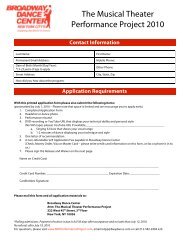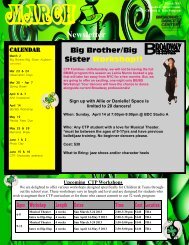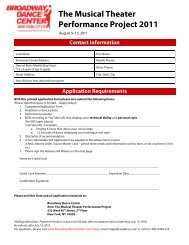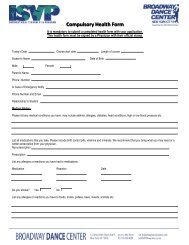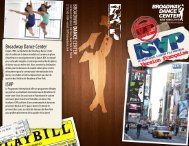You also want an ePaper? Increase the reach of your titles
YUMPU automatically turns print PDFs into web optimized ePapers that Google loves.
Photographed by Matthew Karas
FOCUSon TAP<br />
Tap<br />
out<br />
Loud<br />
BY EMILY MACEL<br />
The multitalented,<br />
<strong>Michelle</strong> <strong>Dorrance</strong><br />
multifaceted<br />
tice one riff for an hour or I’ll practice<br />
700,000 things in an hour.”<br />
<strong>Dorrance</strong> speaks like she taps—fast<br />
and rhythmically, only pausing to interrupt<br />
herself with another thought, taking<br />
the conversation to a new tonality.<br />
One minute she’s riffing on a great tap<br />
mentor, the next she slides into talking<br />
about a hip hop show she saw on<br />
Saturday night, then does a paddle roll<br />
about a collaborative music and dance<br />
project she’s got brewing. It’s the subtlety<br />
in her syncopation that keeps you<br />
tuned in.<br />
She’s tall and slender with a youthful<br />
face and a bright, toothy grin. It’s<br />
rare to see her without big silver hoop<br />
is stompin’ up a storm.<br />
ittakes a certain kind of<br />
person to be a plate<br />
spinner. You know, one<br />
of those people who<br />
starts spinning one plate on a tall pole,<br />
then a second and a third before coming<br />
back to the first to make sure it’s still<br />
going while spinning a fifth and a sixth.<br />
It requires an awareness of everything<br />
around you, of your audience, of each<br />
particular plate. And, of course, of yourself<br />
in the space so you don’t accidentally<br />
knock a pole over.<br />
<strong>Michelle</strong> <strong>Dorrance</strong> is the plate spinner<br />
of the tap world. She’s got so many<br />
plates going at one time that it seems like<br />
the more she does, the more plates she<br />
can put in the air. “I like to think it’s an<br />
organized chaos,” says <strong>Dorrance</strong>. “The<br />
chaos fuels itself.” A self-proclaimed<br />
extremist, she says, “Sometimes I’ll pracearrings<br />
and her hair in two messy pigtail<br />
buns. She may look young and delicate,<br />
but she’s no waif. Power pulses<br />
through her body.<br />
Though she’s been tapping for nearly<br />
as long as she’s been walking, she’s<br />
branching out. You can now see her six<br />
times a week in the long-running off-<br />
Broadway show Stomp. In a cast of<br />
mainly men, <strong>Dorrance</strong> holds her own,<br />
and then some. The youngest and<br />
newest member to the Stomp family (she<br />
joined last November), <strong>Dorrance</strong> plays a<br />
role that’s called “Bin Bitch.” Her character’s<br />
got a tough demeanor and wears<br />
a pissed off, unimpressed look on her<br />
face when the jokers of the cast try to<br />
show off. Though she’s a newbie, she<br />
has the dance chops to stand up against<br />
the more experienced cast members.<br />
She’s intense—her furiously fast<br />
DANCE MAGAZINE 33
FOCUSon TAP<br />
footwork alternates with beating out<br />
rhythms on trash can lids, hollow pipes,<br />
matchboxes, and Zippo lighters.<br />
“I’ve always wanted to be a kit<br />
drummer, a guitarist, a b-girl. Stomp is a<br />
manifestation of that. It’s a challenge I’m<br />
happy to indulge in. It’s also helping my<br />
timing and my ear for sound,” she says.<br />
Trained for her role by Fritzlyn Hector,<br />
an original Stomp cast member,<br />
<strong>Dorrance</strong> says what she loves about the<br />
show is that it incorporates “the myriad<br />
styles that I’ve had the opportunity to<br />
connect with.”<br />
<strong>Dorrance</strong> with the<br />
crew of Stomp<br />
You could say <strong>Michelle</strong> was born<br />
with skilled feet. Her mother, M’Liss<br />
<strong>Dorrance</strong>, was a member of Eliot Feld’s<br />
American Ballet Company. Her father,<br />
Anson <strong>Dorrance</strong>, is a soccer coach who<br />
led the Women’s U.S. team to the World<br />
Cup in 1991. Growing up in North<br />
Carolina, <strong>Michelle</strong> was exposed to both<br />
of her parents’ passions. She played soccer<br />
and grew up in her mother’s ballet<br />
studio, the Ballet School of Chapel Hill.<br />
<strong>Michelle</strong> says she appreciates the skill<br />
and devotion it takes to make it in the<br />
ballet world, but it was never for her.<br />
“With tap, I was good immediately,<br />
which was part of why it was so rewarding,”<br />
she says. “There was never anything<br />
that felt unnatural. In ballet there<br />
is a rigidity in the form and you need to<br />
have a close to perfect line, but I have<br />
flat feet. I didn’t have my mother’s flexibility<br />
and legs.”<br />
She began classes with Gene Medler<br />
in the early ’90s and joined his company,<br />
the North Carolina Youth Tap Ensemble,<br />
or NCYTE. “He taught us to improvise<br />
at a young age. That’s a landmark for my<br />
generation of dancers.”<br />
Medler says, “<strong>Michelle</strong> was on the<br />
front edge of that wave of my improvisational<br />
teaching.” Though she was a member<br />
of his company, Medler says, “We<br />
learned side by side. It was obvious that<br />
Top: Matthew Karas. Bottom: Colin Fowler<br />
34<br />
MAY 2008
she had a tremendous gift for tap. I tried<br />
to open doors for her and just get out of<br />
her way.”<br />
Medler sought out dancers of different<br />
styles to set works on the group,<br />
including Josh Hilberman, Barbara<br />
Duffy, Savion Glover, Margaret<br />
Morrison, Brenda Bufalino, and Lane<br />
attend New York University. Like most<br />
universities, NYU doesn’t offer a tapspecific<br />
dance program, but that didn’t<br />
stop her from making tap her focus. She<br />
graduated from the Gallatin program<br />
with a self-created major that focused on<br />
American democracy and race within the<br />
arts. “Tap is a true American art form<br />
as a busker. She talks about the<br />
endurance you learn from performing<br />
on the street: “There is nothing as honest<br />
as a street crowd because they don’t<br />
have to be there.”<br />
A New Yorker for 10 years,<br />
<strong>Dorrance</strong>, 28, has dipped her toes into<br />
many of the pools of tap groups across<br />
“She has monstrous technique and<br />
a funny, quirky view of the world.”<br />
—Josh Hilberman<br />
Alexander. “I couldn’t ask for a better<br />
preprofessional experience,” says<br />
<strong>Dorrance</strong>. “We would go to schools and<br />
do ‘educationals’ and give the history of<br />
tap. It gave me a connection to the history<br />
of the form at a young age.”<br />
Hilberman, who has been working<br />
with <strong>Dorrance</strong> for more than 15 years,<br />
says, “She has technical power that is<br />
huge. She has monstrous technique. She<br />
has a funny, quirky view of the world.<br />
She falls between the young killer women<br />
in high heels and the guys.” Hilberman<br />
calls <strong>Dorrance</strong> a pluralist for her ability to<br />
“galvanize influences from all over.”<br />
<strong>Dorrance</strong> left North Carolina to<br />
and what America is supposed to be,”<br />
she says. “Not the bastardized patriotism,<br />
but a real blending of cultures.”<br />
While <strong>Dorrance</strong> was in college,<br />
Savion Glover recruited her to work with<br />
him and eventually be a founding member<br />
of his company Ti Dii. “I have<br />
learned an infinite amount from him,”<br />
<strong>Dorrance</strong> says.<br />
She met a lot of tappers at Buster<br />
Brown’s tap jams, Swing 46, and felt<br />
immediately welcomed into the New<br />
York tap community. The accessibility<br />
and fast pace of the city intrigued her.<br />
She has collaborated in other art<br />
forms—in theater, with musicians, and<br />
the city. “I’ve had so many solid experiences<br />
with such a diverse blend of styles<br />
and approaches to the form. Tap dancers<br />
are such a small community.” She’s<br />
worked on projects with Glover, Jimmy<br />
Slyde, Dianne Walker, Brenda Bufalino,<br />
Heather Cornell, Barbara Duffy, Max<br />
Pollack, and Marc Mendoca to name a<br />
few. In her generation of tappers, she’s<br />
been a part of Ayodele Casel’s Diary of<br />
a Tap <strong>Dance</strong>r and Tappy Holidays!,<br />
Derick Grant’s Imagine Tap!, and Jason<br />
Samuels Smith’s Charlie’s Angels,<br />
which she performed last summer at<br />
Tap City.<br />
For the sexy Charlie’s Angels trio,<br />
DANCE MAGAZINE 35
FOCUSon TAP<br />
Above: <strong>Dorrance</strong> at the Celebration of Tap, NYC, last year.<br />
Right: <strong>Dorrance</strong>, Dormeshia Sumbry-Edwards, and Chloe<br />
Arnold in Charlie’s Angels at Tap City. Below: <strong>Dorrance</strong><br />
with Mable Lee’s Dancing Ladies.<br />
ups to Daft Punk and the Eurythmics,<br />
and a slide combination to Lauryn Hill.<br />
“Music drives so much of what I feel in<br />
my dancing.”<br />
<strong>Dorrance</strong> returns to her hometown<br />
now and then, setting works on NYCTE.<br />
“She’s come full circle,” Medler says.<br />
“She comes back and is a tremendous<br />
influence, I continue to learn from her.”<br />
What’s next for <strong>Dorrance</strong>? Audiences<br />
got a sneak peak of her choreographic<br />
suite to Regina Spektor’s music last sum-<br />
<strong>Dorrance</strong> danced with Dormeshia<br />
Sumbry-Edwards, a tapper she looks up<br />
to. “To me, she is the full package,” she<br />
says, “from Anne Miller style to slamming<br />
down some funky syncopation<br />
into the floor. She’s sophisticated and<br />
technically unbelievable. She’s a very<br />
serious inspiration.”<br />
In the weekly class she teaches at<br />
Broadway <strong>Dance</strong> Center, <strong>Dorrance</strong><br />
makes references to her mentors and<br />
colleagues, and gives mini-history lessons<br />
(a habit from her NCYTE days).<br />
She also uses images to get her students<br />
to understand. “In tap the<br />
form follows function. You<br />
think, I need to get this<br />
wing over here, so you figure<br />
out a way to do that. It’s<br />
like how a bird flies in the<br />
most efficient way possible,”<br />
she says. “Or pterodactyls. I<br />
relate to pterodactyls.”<br />
Her love of music is obvious.<br />
She has her students work<br />
on heel dropping combinations<br />
to Michael Jackson songs, pickmer<br />
at Tap City. <strong>Dorrance</strong> performed to<br />
the Russian-born singer-songwriter’s<br />
rhythmic ballad Baobabs, sung by<br />
<strong>Dorrance</strong>’s friend and collaborator<br />
Miriam Chicurel. <strong>Dorrance</strong> and<br />
Spektor’s “voices” are well-matched—<br />
both have a rhythmic, sweet yet mischievous<br />
quality to them.<br />
And goals? Yeah, she’s got those.<br />
Many of her grand plans involve learning<br />
to be a musician not only with her feet.<br />
In the mornings, <strong>Dorrance</strong> plays a song<br />
on her ukulele. And, “I’m a wannabe<br />
guitar player, bass player, and claw<br />
hammer banjo player. I’m a nonpracticing<br />
wannabe harmonica player.”<br />
Adding a few more spinning plates to<br />
the mix, she’s also penned an unpublished<br />
children’s book using her own<br />
photography of New York City<br />
water towers.<br />
But of all her interests, tap dancing<br />
still comes first. “When I hear it,<br />
when I feel it, I want to do it.”<br />
Emily Macel is an associate editor<br />
at <strong>Dance</strong> <strong>Magazine</strong>.<br />
Photos this page: Debi Field<br />
36<br />
MAY 2008



